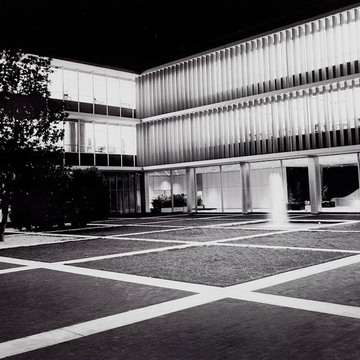Richard S. Reynolds, the founder of Reynolds Metals Company and a nephew of R. J. Reynolds, himself founder of the tobacco company, began in the soap business and wound up producing cigarette foil. In 1940 the corporate headquarters was relocated from New York to downtown Richmond. That same year the company became an aluminum producer. During World War II Reynolds Metals provided nearly a billion pounds of aluminum for use in military equipment. Reynolds Wrap was introduced in 1947, and in 1963 the company produced the first all-aluminum twelve-ounce beverage can.
MIT-trained Gordon Bunshaft, head designer for Skidmore, Owings and Merrill's New York office, was also responsible for other nationally acclaimed corporate headquarters buildings, including Lever House, New York (1949–1952), and the Connecticut General Life Building, Bloomfield, Connecticut (1954–1957). The Reynolds headquarters showcases the company's major product: aluminum is employed as trim; for the sun louvers on the south, east, and west facades; on interior partitions; and for hardware, special file cabinets,
Completely symmetrical, with an open-air central court, the building features horizontal layering: base, piano nobile, and cornice, the composition common to the Italian palazzo tradition. The geometric lightness of the design is underscored by the reflecting pool (205,000 gallons) that fronts the entrance facade and serves as a reservoir for cooling and irrigation systems. A restrained complement to the rectilinear formality of the building is the interior court, a design incorporating gridded squares of grass and flowers, a magnolia tree, and a fountain, by Charles F. Gillette, the landscape architect for some of Richmond's finer “Banker's Georgian” houses. Positioned on a prominent rise, the building is an early corporate temple. Although he never admitted to the classical tendencies of the design, Bunshaft did remark: “This is how a temple should have been approached.” Furnished with modern furniture, the building remains in pristine condition. It has been acquired by the University of Richmond for use as a conference center.














